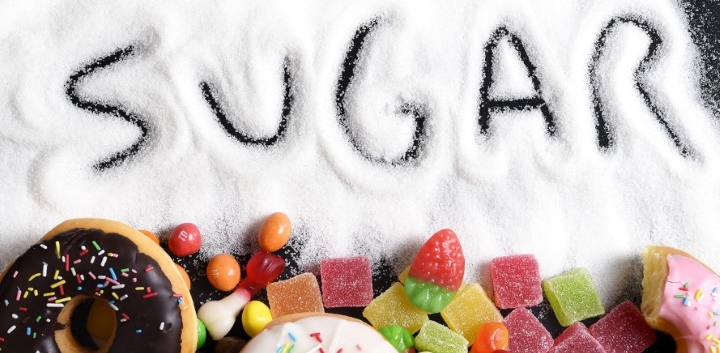Our bodies need a small amount of sugar (glucose) to survive and if we were to eliminate it completely from our diet the cells in our bodies would die. However, almost without exception we are all consuming far too much sugar.
Guidelines now state we should be having no more than six teaspoons of sugar a day.
Too much sugar raises the risk of many health problems, including obesity, type 2 diabetes, heart disease and even Alzheimer’s.
But many of us have no idea how much sugar is in the foods and drinks we consume. Here are some common foods and drinks with their sugar levels.
Chocolate bars
- Snickers (52.7g) – 6.75 teaspoons of sugar
- Milk chocolate bar(44g) – 5.75 teaspoons of sugar
- Milky Way bar(58g) – 8.75 teaspoons of sugar
- Twix bar(50.7g) – 6 teaspoons of sugar
- Milk chocolate M&M’s packet(47.9 g) – 7.5 teaspoons of sugar.
Soft drinks
- Coca cola(one can) – 8.25 teaspoons of sugar
- Pepsi cola(one can) – 8.75 teaspoons of sugar
- Red Bull(one can) – 6.9 teaspoons of sugar
- Sprite(one can) – 8.25 teaspoons of sugar
- Mountain Dew(one can) – 11.5 teaspoons of sugar
- Old Jamaica Ginger Beer(one can) – 13 teaspoons of sugar.
Breakfast cereal
*(per 100 grams)
- Alpen– 5.75 teaspoons of sugar
- Cheerios– 1 teaspoon of sugar
- Corn Flakes– 2.4 teaspoons of sugar
- Cocoa Krispies– 9.75 teaspoons of sugar
- Froot Loops– 10.5 teaspoons of sugar
- Frosted Flakes – 8.75 teaspoons of sugar
- Honey Smacks– 14 teaspoons of sugar
- Rice Krispies– 2.5 teaspoons of sugar
- Special K – 3 teaspoons of sugar
- Wheaties– 3.75 teaspoons of sugar
- Honey Nut Cheerios – 8.25 teaspoons of sugar
- Golden Grahams – 8.75 teaspoons of sugar
- Cocoa Puffs – 9.25 teaspoons of sugar
- Shredded Wheat– 0.1 teaspoons of sugar
Cereals aimed at children tend to be far worse than those aimed at adults, with around 56% more sugar, half as much fibre and 50% more sodium (salt).
How much sugar does fruit contain?
Fruit may not contain added sugar, but it does contain fructose, a type of sugar, so does count toward your daily sugar intake.
*per 100 grams.
- Mangos– 3.2 teaspoons of sugar
- Bananas– 3 teaspoons of sugar
- Apples– 2.6 teaspoons of sugar
- Pineapples– 2.5 teaspoons of sugar
- Grapes– 4 teaspoons of sugar
- Lemons– 0.6 teaspoons of sugar
- Kiwi fruit– 2.3 teaspoons of sugar
- Apricots– 2.3 teaspoons of sugar
- Strawberries– 1.3 teaspoons of sugar
- Raspberries– 1 teaspoon of sugar
- Blueberries– 1.7 teaspoons of sugar
- Cranberries– 1 teaspoons of sugar
- Tomatoes– 0.7 teaspoons of sugar.
Cakes and desserts
- Banoffee pie(1 medium portion) – 4.25 teaspoons of sugar
- Carrot cake(1 medium slice) – 3 teaspoons of sugar
- Custard(1 medium portion) – 3.25 teaspoons of sugar
- Chocolate mousse(1 medium portion) – 3 teaspoons of sugar
- Donut(1 jam doughnut) – 3.5 teaspoons of sugar
- Fruit pie(1 medium portion) – 3.5 teaspoons of sugar
- Fruit cake(1 medium slice) – 5 teaspoons of sugar
- Muffin(one chocolate chip muffin) – 4.75 teaspoons of sugar
- Ice cream(1 scoop) – 3 teaspoons of sugar
- Rice pudding(1 portion) – 3.75 teaspoons of sugar
- Sponge cake(1 medium slice) – 5.5 teaspoons of sugar
- Swiss roll(1 roll) – 2.5 teaspoons of sugar.
To find out more about sugar, watch these videos
Sugar: The bitter truth
Robert H. Lustig, MD, UCSF Professor of Paediatrics in the Division of Endocrinology, explains his views on the damage caused by sugary foods. He argues that too much fructose and not enough fibre appear to be behind the obesity epidemic because of their effects on insulin.
The Secrets of Sugar – Science Channel National Geographic
This documentary investigates the dangers of sugars and looks at how scientists and the sugar industry have clashed.

